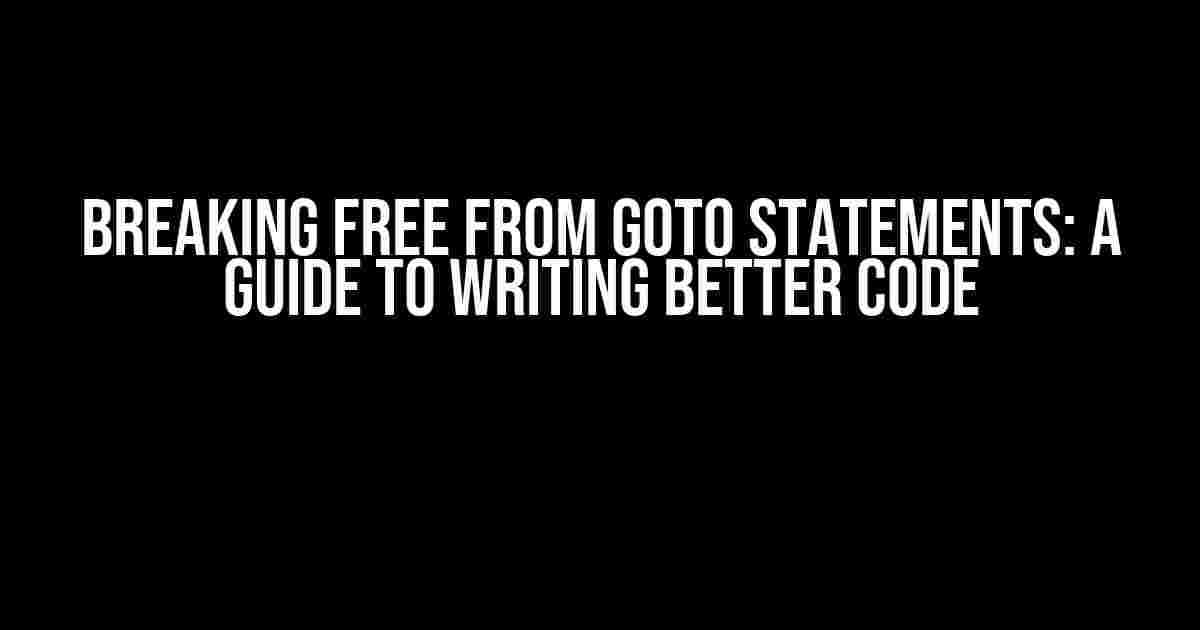Are you tired of using goto statements in your code? Do you want to write more efficient, readable, and maintainable programs? You’re in the right place! In this article, we’ll explore the reasons why goto statements are often considered harmful and provide you with practical tips and techniques to avoid them altogether.
The Problem with Goto Statements
Goto statements, also known as jump statements, allow you to transfer control to a labeled statement in your code. While they might seem convenient, they can lead to:
- Spaghetti code**: Goto statements can create a tangled mess of jumps and labels, making it difficult to follow the program’s flow.
- Debugging nightmares**: With goto statements, it’s challenging to identify and fix errors, as the program’s control flow is hard to track.
- Maintenance hell**: Goto statements make it difficult to modify or extend your code, as changes can have unintended consequences.
Why You Should Avoid Goto Statements
There are several reasons why goto statements are considered a bad practice:
- Readability**: Goto statements break the natural flow of your code, making it harder for others (and yourself) to understand.
- Testing**: With goto statements, it’s challenging to write unit tests or integrate your code with automated testing tools.
- Code reviews**: Goto statements can lead to lengthy and painful code reviews, as others struggle to comprehend your code.
- Best practices**: Most programming languages and coding standards discourage the use of goto statements.
Alternatives to Goto Statements
Fear not, dear programmer! There are many alternatives to goto statements that can help you write better code:
1. Structured Programming
Structured programming is an approach that emphasizes a logical, hierarchical structure for your code. Use:
ifstatements to control flow based on conditionsswitchstatements to handle multiple casesloops(e.g.,for,while,do-while) to iterate over data
if (condition) {
// code to execute if condition is true
} else {
// code to execute if condition is false
}2. Functions and Procedures
Break down your code into smaller, reusable functions and procedures. This approach:
- Improves code organization and readability
- Reduces code duplication
- Makes it easier to test and debug individual components
function greetUser(name) {
console.log(`Hello, ${name}!`);
}
greetUser('John');3. Table-Driven Design
Table-driven design involves using data structures (e.g., arrays, objects) to drive the program’s flow. It’s particularly useful for:
- Handling complex logic and decision-making
- Implementing state machines and finite automata
const transitions = {
'start': { 'a': 'state1', 'b': 'state2' },
'state1': { 'c': 'state3', 'd': 'state4' },
'state2': { 'e': 'state5', 'f': 'state6' },
// ...
};
let currentState = 'start';
while (true) {
const input = readInput();
const nextState = transitions[currentState][input];
currentState = nextState;
// ...
}Real-World Examples
Let’s look at some examples of how you can rewrite code that uses goto statements:
Example 1: Simulating a Traffic Light
| State | Input | Next State |
|---|---|---|
| green | timeout | yellow |
| yellow | timeout | red |
| red | timeout | green |
let currentState = 'green';
while (true) {
const input = readlineSync.question('Enter "timeout" to change the light: ');
switch (currentState) {
case 'green':
if (input === 'timeout') {
currentState = 'yellow';
}
break;
case 'yellow':
if (input === 'timeout') {
currentState = 'red';
}
break;
case 'red':
if (input === 'timeout') {
currentState = 'green';
}
break;
}
console.log(`The light is ${currentState}.`);
}Example 2: Parsing a CSV File
const csvData = [
['Name', 'Age', 'Occupation'],
['John', 25, 'Developer'],
['Jane', 30, 'Manager'],
['Bob', 35, 'CEO'],
];
let rowIndex = 0;
while (rowIndex < csvData.length) {
const row = csvData[rowIndex];
if (row[0] === 'John') {
console.log(`Found John's data: ${row.join(', ')}`);
}
rowIndex++;
}Conclusion
Avoiding goto statements takes practice and patience, but the benefits are well worth the effort. By using structured programming, functions, and table-driven design, you can write more efficient, readable, and maintainable code.
Remember, the next time you're tempted to use a goto statement, take a step back and ask yourself:
- Can I simplify the logic using if-else statements or switch cases?
- Can I break down the code into smaller, reusable functions?
- Can I use a data structure to drive the program's flow?
By following these guidelines and techniques, you'll be well on your way to writing better code and breaking free from the shackles of goto statements.
So, what are you waiting for? Start refactoring your code today and experience the joy of writing maintainable, efficient, andgoto-free programs!
Further Reading
Want to learn more about writing better code and avoiding goto statements? Check out these resources:
- Structured Programming on Wikipedia
- The Goto Statement: A Relic of the Past
- Code Complete: A Practical Handbook of Software Construction
Happy coding, and remember: no goto statements allowed!
Here are the 5 questions and answers about "How can I write this code without goto statements":
Frequently Asked Question
Got stuck with goto statements in your code? Worry not, we've got you covered!
Can I replace goto statements with conditional statements?
Yes, you can! In many cases, goto statements can be replaced with conditional statements like if-else or switch-case. For example, instead of using a goto statement to jump to a specific label, you can use an if-else statement to conditionally execute a block of code.
How can I use loops to avoid using goto statements?
Another way to avoid goto statements is to use loops. For instance, if you're using a goto statement to repeat a block of code, you can replace it with a while loop or a for loop. This way, you can control the flow of your program without jumping around.
Can I use functions to encapsulate code blocks and avoid goto statements?
Absolutely! Functions are a great way to encapsulate code blocks and avoid using goto statements. By breaking down your code into smaller functions, you can reduce the need for jumping around and make your code more modular and readable.
Are there any specific coding patterns or techniques that can help me avoid goto statements?
Yes, there are several coding patterns and techniques that can help you avoid goto statements. For example, you can use the "extract function" pattern to break down long methods into smaller, more manageable pieces. You can also use the "replace nested conditional with guard clauses" pattern to simplify your code and reduce the need for goto statements.
Are there any situations where using goto statements is unavoidable?
While it's generally recommended to avoid using goto statements, there may be certain situations where they are unavoidable. For example, in low-level programming or embedded systems, goto statements may be necessary for performance or memory constraints. However, even in these cases, it's essential to use goto statements judiciously and with caution.



